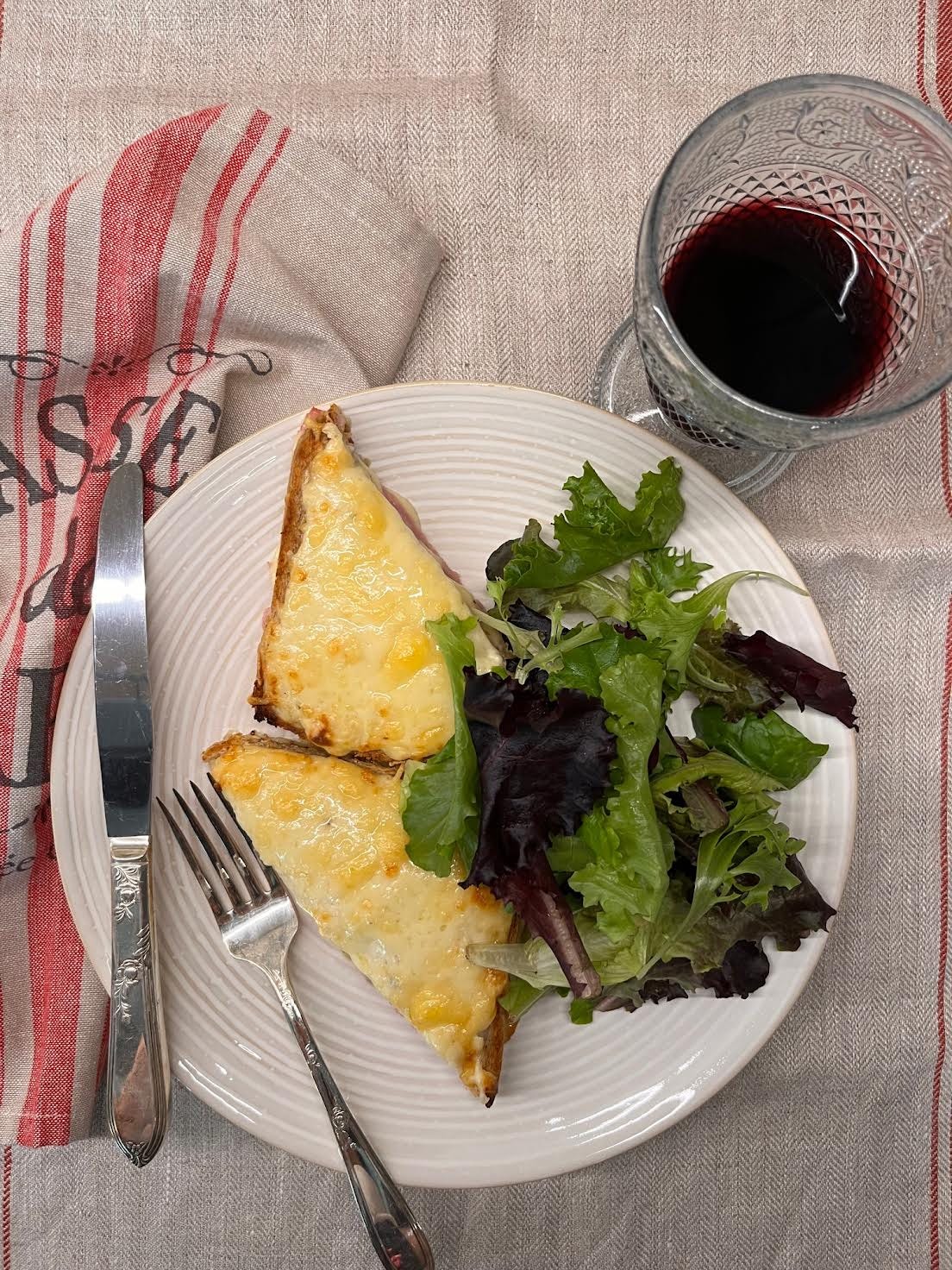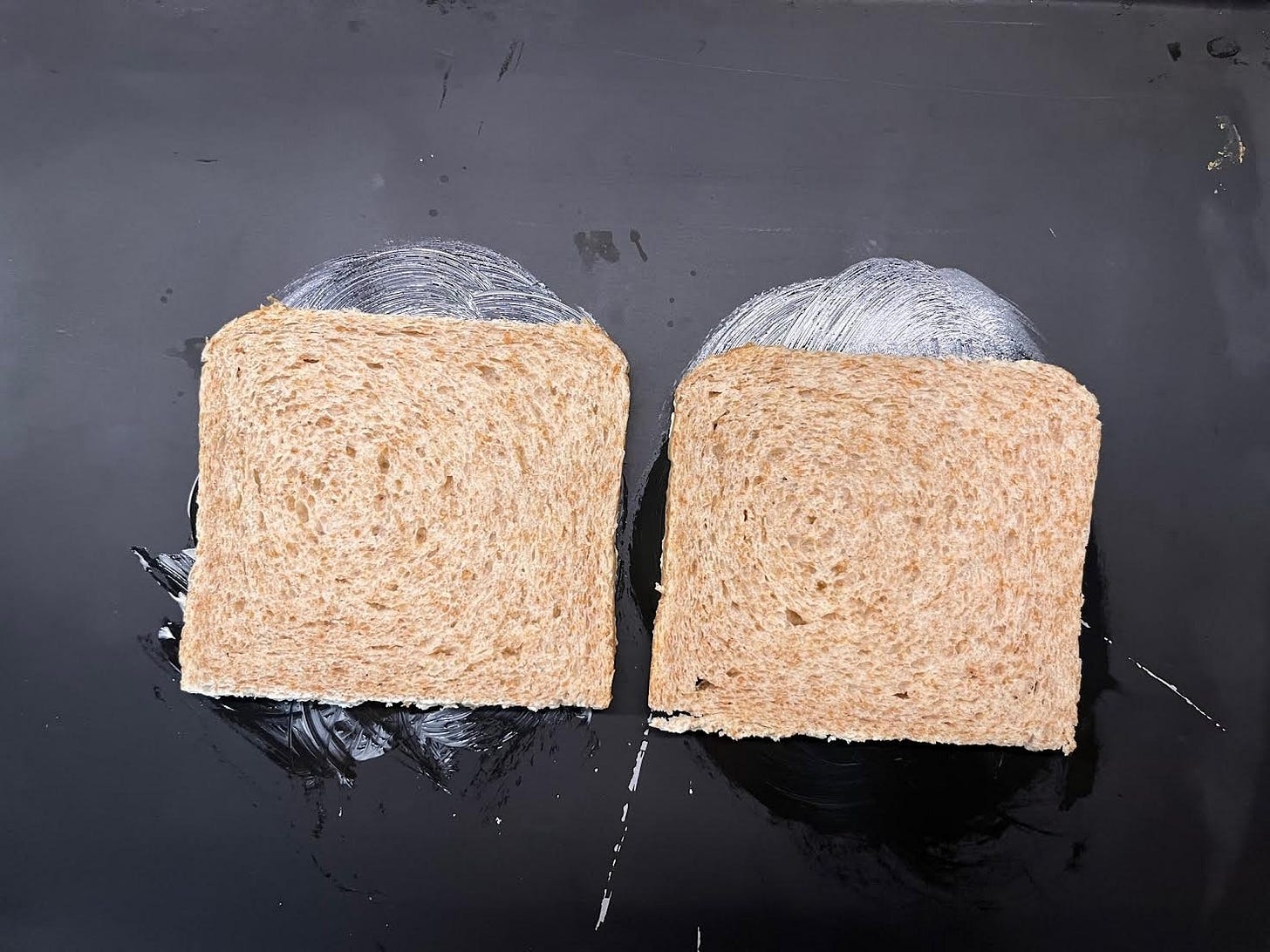Man is good, but veal is better. - Bertolt Brecht
It’s a funny story, really.
Michel Lunarca ran a popular dining establishment on the boulevard des Capucines in Paris in the very early years of the 20th century. The former owner of Le Bel Âge, having no heirs, chose to bequeath the popular brasserie to Lunarca, his young employee, with whom he apparently had developed a bond, confident in his hard work and pleased with his faithful service.
Increasingly large crowds began to frequent Le Bel-Âge as Lunarca cleverly began offering sandwiches at good prices to a clientele looking only for a quick, inexpensive midday meal on the go, or the after-theater crowd looking for a light bite. Le Bel-Âge, much to the chagrin of his competitors, quickly became the trendy spot for lunch and supper. Competition between neighborhood brasseries, bistros, and cafés being fierce (and Lunarca was known to be the fiercest), rumors about the young upstart began to circulate among the other restaurateurs jealous of his success, rumors that quickly spread to the clientele. Tongues wagged and the word spread that Michel Lunarca was a cannibal. And that he served human meat in his establishment.
You have to admit it kind of makes sense, the nickname “The Cannibal” rather fitting, as crazy as it sounds. You see, Lunarca’s first job as a lad of ten was as assistant to Paris’ famous - and infamous - bourreau - public executioner, Anatole Deibler. Years later, when he came of age, and deciding to change professions, Lunarca chose to become - of all things - a butcher. Before joining the kitchen staff at Le Bel-Âge.
Michel Lunarca is considered by many sources to have been the first to have the croque-monsieur on his menu in Paris. Thus, in France. And some even believe he invented it. While sandwiches had been all the rage, they were always served on baguette. But, as popular legend has it, Lunarca, finding himself short of baguettes during one lunch rush, dashed to the boulangerie for more, only to find the shelves empty. The only bread he could find was pain de mie, simple loaves of what we think of today as sandwich bread, which, at that time, was looked down upon as being the bread of those English… But he layered ham and cheese between slices of the bread and grilled it in butter to crisp the outside and it was enthusiastically received.
One client, having heard the rumors spreading quickly around the capital, questioned the proprietor himself: “What is in this sandwich that makes it so special?” “Well,” replied Lunarca jokingly, “de la viande de monsieur, the meat of a gentleman”.
The joke became legendary and the croque-monsieur - croque (bite or crunch) + monsieur (gentleman) - became a staple on the menu of Le Bel-Âge in the year 1910.
While Michel Lunarca might very well have been the first to serve the croque-monsieur in a restaurant, he certainly didn’t come up with either the recipe or the name, and he wasn’t even the first to use pain de mie, sandwich bread, for the croque-monsieur. The croque-monsieur already, in fact, existed before the turn of the century and before it appeared on his menu. The Septembre 25, 1891, issue of La Revue Athlétique featured a story, En Wherry, in which appeared the fabled sandwich:
“It is late and we are very hungry. What should we do for lunch? Ham becomes monotonous in the long run. The Diplomat, who is a bit of a gourmand, and in this he resembles Talleyrand, has an idea. ‘Let's make croque-monsieurs’. Quickly, the toast, the butter, the Gruyère cheese, the ham, a little cayenne pepper and we are at work. One cuts, another butters, the third puts it all together into sandwiches that Vincent fries in the pan. They are exquisite, the croque-monsieurs, a little big perhaps, made for the jaws of giants, but who cares? We eat them, we come back to them, we are delighted.” The author then goes on to call les croque-monsieurs … les grogne-monsieurs as this hearty, rich snack is enough to make a man groan.
In 1896, the journalist Arnolphe lavishes praise on “un plat tout à fait délicieux” - “quite a delicious dish that I have just eaten, and I cannot resist the urge to share the recipe with you. You take English bread, sandwich bread. You cut it up and make real sandwiches out of it, with butter and ham; however, you place the ham between two very thin slices of Gruyère cheese. You then pan-fry your sandwiches in a little butter. Serve with salad. They're called croque-monsieurs.”
“If Homer and Virgil are to be believed,” Arnolphe continues, quite mysteriously, “these little sandwiches of a new kind were very popular in the Underworld. They were called croque-morts (undertakers).” For the same reason, I imagine, that the other author referred to these warm, copious sandwiches as les grogne-monsieurs.
But were they “the new kind”? While I have had no luck pinpointing the origin of this classic French lunch staple, I imagine these might very well be the earliest mentions of the croque-monsieur in the press. The sandwich itself was said by many to have been created 2 centuries earlier, famously by John Montagu, 4th Earl of Sandwich, diplomat and admiral of the British fleet under King George III. And yet there are many French who dispute this fact, or rather believe that while the sandwich was invented by the English, the French popularized it. And may very well have been eating it earlier.
Lord Sandwich might have lent his name to the sandwich, but eating meats and cheeses on bread has been around since at least the beginnings of the Common Era. By the Middle Ages, thick slices of bread were being used as plates, the bread serving as both food and utensil (although oftentimes, the bread used thus by the wealthy was tossed to the dogs or the servants after the meat was eaten). Louis XIV was thought to order small brioches filled with meats or a chicken stuffing for his hunting parties. In fact, there is a suspicion that the “monsieur” of croque-monsieur refers to Monsieur, Philippe d’Orléans, younger brother of King Louis XIV. Monsieur, was a great gourmand, known to have loved sandwiches smothered under béchamel, a sauce thought to be created by Louis Béchameil, intendant or manager of the House of Monsieur, in the late 17th century. “He'd gobble up (croquer) a dozen in a jiffy, and couldn't get enough. And that's how we still enjoy Croque-Monsieurs today.” according to a snippet in the February 1, 1936 issue of La France à Table.
Finally, for the stronger sex, we recommend a ham sandwich as a restorative lunch, accompanied by a glass of good Bordeaux, Porto, Chypre, or Madera. It makes you feel immediately more cheerful, better disposed to have lunched like that, and you come to the table with eyes full of indulgence and craving for the delicacies you see there. - Auguste Colombié, La Cuisine Bourgeoise (a practical treatise for young girls, indispensable guide for the housewife), 1906
Paris is famous for its jambon-beurre, evidently a manly sandwich for “the stronger sex”, popularized during the industrialized era of the first half of the 20th century. Workers had no time to for a sit-down repast so ate on the run or at work, and the sandwich was the ideal solution. The jambon-beurre, slices of ham nestled inside a split and well-buttered chunk of baguette, was born in Paris around Les Halles markets and quickly became a popular lunchtime meal. With a glass of wine, no doubt.
But who added the cheese, and who swapped out the baguette for sandwich bread, and who in the world called it a croque-monsieur?
What an odd name, croque-monsieur. Henri Babinski, writing under the moniker Ali-Bab, offers a recipe not for a croque-monsieur but for petits sandwichs chaudes au jambon et au fromage - small hot ham and cheese sandwiches - in his 1912 recipe book Gastronomie Pratique. This “excellent hors d’oeuvre” as he calls them, are made with pain anglais (English bread, meaning sandwich bread), butter, ham, and finely grated gruyère cheese. The crust is removed from the bread which is then sliced, each slice then quartered or sliced in half on the diagonal (to make 2 triangles). Each triangle is buttered and dusted with grated cheese, two of these are then closed together with a slice of ham in the middle. The sandwiches are then fried in a pan in butter until golden.
Even as the croque-monsieur had been written about before the turn of the century, 2 years after they supposedly have become all the rage in Paris thanks to Michel Lunarca, the great and influential Ali-Bab is not yet calling them this, even as his recipe sounds exactly like a croque-monsieur.
Which brings us back to Michel Lunarca and his “de la viande de monsieur” joke. Searching through French history, one comes across two similar turns of phrase, strange colloquialisms using the word croque (to bite) that appear in French popular culture: the croque-mort and the croque-mitaine. The appellation croque-mort seems to have been born during the plague epidemics of the Middle Ages, during which the dead were gathered and piled up waiting for the undertakers to cart away the bodies. Croque-mort, or so the legend goes, refers to the ancient practice of biting down hard on the toe of the deceased to ensure their death by their lack of response. Thus, undertakers would soon be nicknamed, les croque-morts. The croque-mitaine, according to another ancient legend, was an imaginary, fantastical, terrible monster conjured up to frighten naughty children and make them obey, biting off the fingers (mitaine is mitten, so the fingers) and nose of those children who remained incorrigible. So why name a sandwich a croque-monsieur? What exactly are we biting into?
By 1919 they’ve finally become a thing. Again. In À l'ombre des jeunes filles en fleurs (Within A Budding Grove) in 1919, Marcel Proust wrote “Now, as we left the concert and took the road back to the hotel, my grandmother and I stopped for a moment on the dike to exchange a few words with Madame de Villeparisis, who announced that she had ordered croque-monsieur and eggs with cream for us at the hotel.” But while evidently popular with a certain brasserie crowd, not everyone seems to have been familiar with the croque-monsieur. “This hot sandwich, which doesn't often appear on a menu, is wrongly overlooked,” claims Yvonne Delay, women’s columnist of the L’Echo de France in the 7 February 1922. Two years later in the same newspaper, a recipe is offered for Croque-monsieur aux cervelles (brains) prepared with a mustard butter.
Little by very little, “the king of hot sandwiches… the croque-monsieur, with which you're all familiar and which makes an excellent starter” (Mille et un Sandwichs by Yvonne Delay in the Gazette de Bayonne, de Biarritz et du Pays Basque 11 August 1934) are making their way into the popular press and, timidly, into cookbooks. The very popular 1932 Je Sais Cuisinier by Ginette Mathiot, offering family-style recipes for the French home, has a recipe for Croque-messieurs économiques - economical or frugal croques - using only stale bread, gruyère cheese, and butter, made like a grilled cheese sandwich in a skillet. She follows this with a recipe for Croque-messieurs au jambon, specifying pain de mie, sandwich bread, although also preferably stale, and adding slices of ham to the sandwich. The April 22, 1934 issue of the professional magazine La Toque Blanche, has an insert for the restaurant Androuet, serving, among a large variety of dishes, le croque-monsieur au beacon (bacon), le croque-monsieur au roquefort, and le croque-madame au bel-paese, croques made with a variety of cheeses. “Until 2 o’clock in the morning. “
While Yvonne Delay correctly says in her column, “This dish is very simple, of course, and inexpensive, but you must think of making it!” the croque-monsieur doesn’t find its way into a lot of cookbooks; I had a difficult time finding it mentioned in most of the cookbooks in my collection. Of course it is included in the 1950 L’Art Culinaire Française as an hors-d’oeuvre chaud ou petite entrée, a warm or hot hors d’oeuvre or simple first course. Which is also the first time we see the croque-monsieur made with the addition of a béchamel, this béchamel thickened with plenty of grated Parmesan cheese in place of the gruyère, although he does include a separate recipe for the traditional version of a simple sandwich of ham and gruyère slices between 2 slices of bread, the outside buttered copiously, the sandwiches then grilled in a very hot oven and dusted with paprika before serving.

The Larousse’s Collection Pratique Cuisine Express (simple dishes for busy people) of 1952 also has the uncomplicated version of ham and cheese on buttered bread, the sandwiches browned in a pan with hot butter. And Françoise Bernard, the queen of home cooking, includes pretty much the same recipe for a croque-monsieur in her first cookbook Les Recettes Faciles (Easy Recipes) published in 1955, although cooked in margarine rather than butter, as more and more French home cooks do.
Addendum: I can’t help myself, when a mystery remains unsolved I just have to keep digging. And so does my husband. He found two more mentions of the croque-monsieur that predate the ones I found, the 1891 story in La Revue Athlétique and Arnolphe’s praise of the sandwich in his 1896 column Notes d'un Vieux Garçon in La Liberté.
A Dutch guide Nieuwe Vaderlandsche Letteroefeningen (New Dutch Literary Exercises) published in 1837 mentions the croque-monsieur and giving the detailed description as “two slices of white bread with slices of ham and cheese in between and heated until the whole thing melts together.” 1837! And the French novel Intrigue, written in 1880 (possibly by Émile Richebourg) mentions the croque-monsieur twice as if it was a well known food: “Philippe Nérel looks carefully at the menu and suggests a few tempting dishes to Milly, who quickly decides on a simple croque-monsieur. During the meal, she intends to get to the bottom of the story.” and “The rain falls harder and harder on the gray cobblestones of the city. Milly picks at her croque-monsieur. Like a sparrow, she picks at it; sometimes a crumb of toast, sometimes a tiny fragment of ham, sometimes a bit of Gruyère cheese, then another crumb of toast.”
Curiouser and curiouser, as they say…
Croque-Monsieur
For 4 (although I only made 2)
Iconic brasserie food, the croque-monsieur is a classic lunch almost everywhere in France. Served with a green salad, of course, and a glass of red.
My version is the brasserie version, with a simple béchamel, which is the only part of the recipe that requires any real time, attention, and effort. But one should know how to make a béchamel anyway, so here you go.
Béchamel
This makes a thicker béchamel - a white sauce - than I make for French Mac & cheese or a gratin because you want it spreadable rather than pourable so it will stay on the top of the croque while cooking.
2 tablespoons (30 grams) butter
3 level tablespoons flour
1 ¼ cups (300 ml) milk, whole or low-fat - you can replace some of the milk with a tangy crème fraîche if you like
Salt
Nutmeg
Cayenne pepper
Melt the butter in a small saucepan over low heat; just as the butter is completely melted, add the flour all at once and, whisking constantly, cook for just 1 or 2 minutes so it will “dry out” a bit. This is a roux. Add the milk in thirds, whisking constantly, blending well after each addition; once all of the milk has been added and the roux (flour and butter) is well incorporated into the liquid, add salt, a pinch of nutmeg, and a large pinch of Cayenne. Continue whisking (do not stop whisking) and cooking for about 5 minutes. The béchamel will thicken and any small lumps should disappear, leaving a smooth, thick, creamy sauce. Taste and whisk in more salt, if needed. Remove from the heat and allow to cool for several minutes while you preheat the oven and prepare the ingredients for the sandwich.
Croque-Monsieur
Butter or margarine
2 slices of sandwich bread per croque
2 slices of ham per croque, each slice the size of the bread
2 slices of Gruyère or other hard, flavourful nutty cheese (Gruyère, Emmenthal, Comté) per croque
Béchamel
A few tablespoons grated cheese (Gruyère, Emmenthal, Comté) per croque
Mustard, optional
Preheat the broiler of your oven and have a baking sheet ready.
Butter the bottom side of one slice of bread per croque; place these slices butter-side down on a baking sheet that has been lightly buttered just where the slices of bread will sit. Spread a layer of béchamel on the slices of bread on the baking sheet, about as thick as if you were spreading it with mayonnaise. Lay 1 slice of cheese on each sandwich, then 2 slices of ham, then a second slice of cheese. Spread each remaining “partner” slice of sandwich bread with either a little mustard or butter and press it down onto the croques on the baking sheet.
Spread béchamel on top of each sandwich thickly then cover generously with grated cheese.
Slip the baking sheet into the oven under the broiler and, watching carefully, broil until the cheese on top is bubbling and browned; the inside slices of cheese should also have melted.
Remove from the oven, allow to cool slightly, and serve with a salad.
Thank you for subscribing to Life’s a Feast by Jamie Schler where I share my recipes, mostly French traditional recipes, with their amusing origins, history, and anecdotes. I’m so glad that you’re here. You can support my work by sharing the link to my Substack with your friends, family, and your social media followers. If you would like to see my other book projects in the making, read my other essays, and participate in the discussions, please upgrade to a paid subscription.












Delightful, looks delicious, once again you've delivered a charming piece that leaves one craving more! 💙
Re Milly and her croque-monsieur. If the sandwich was considered everyday fare it would not be surprising that recipes for it would not be written about in gastronomical treatises. So it makes sense that it was probably an idea that existed for some time before someone though to culinarily record it for posterity.